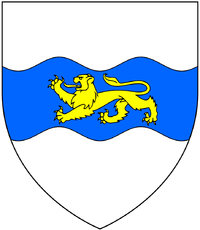Richard Acland (1679–1729)

 ). Sculpted heraldic achievement (circa 1700-1729) on pediment of brick archway to stable block, Fremington House. The crest of A demi-wyvern facing to dexter, wings displayed chequy argent and sable is the crest of Acland of Barnstaple and Fremington, which differs entirely from that of Acland of Acland, Landkey and Killerton
). Sculpted heraldic achievement (circa 1700-1729) on pediment of brick archway to stable block, Fremington House. The crest of A demi-wyvern facing to dexter, wings displayed chequy argent and sable is the crest of Acland of Barnstaple and Fremington, which differs entirely from that of Acland of Acland, Landkey and KillertonRichard II Acland (1679-1729), lord of the manor of Fremington, near Barnstaple in North Devon, was MP for Barnstaple 1708-13. Following his marriage in 1700 to a wealthy heiress he built the large and grand Queen Anne style mansion house known as Fremington House, which survives with 19th century alterations. His arms are displayed on the parapet of Queen Anne's Walk in Barnstaple, as one of about twelve such arms representing members of the Corporation of Barnstaple who financed the building, completed in 1713, now grade I listed, originally called the "Mercantile Exchange", on Barnstaple Quay.
Origins
He was the son of Richard I Acland (d.1703), of Fremington, a merchant of Barnstaple, who purchased the Manor of Fremington in 1683 and was nominated Mayor of Barnstaple in 1688,[1] but did not serve.[2]
The Acland family of Barnstaple appears to have been a junior branch of the Acland Baronets of Killerton House in Devon and Holnicote in Somerset, which originated in the 12th century at the estate of Acland, Landkey in North Devon, two miles east of Barnstaple, and which by the 19th century was one of the largest landowners in the Southwest of England.[3] The exact relationship of the Aclands of Barnstaple to the Acland Baronets is unclear as the Barnstaple "mercantile family" of Acland is not mentioned in the Heraldic Visitations pedigree of the Acland "gentry family".[4] The coat of arms of the two branches is identical, (Chequy argent and sable, a fesse gules) but the crests differ.[5]
Marriage & progeny
In 1700 he married Susanna Lovering (d.1747), the younger of the two daughters and co-heiresses of John Lovering (d.1686), a wealthy merchant, of Weare Giffard (where he founded a school), Countisbury[1] and Hudscott, Chittlehampton, all in North Devon.Susanna's elder sister and co-heiress was Dorothy Lovering, wife of her first cousin Samuel I Rolle (1669-1735) of Hudscott, MP for Barnstaple between 1705 and 1708, a member of a cadet branch of the influential Rolle family of Stevenstone, near Great Torrington, Devon. He was the eldest son of Dennis Rolle (1638-1671) of Great Torrington, a lawyer of the Inner Temple, a younger son of Sir Samuel Rolle (died 1647), MP, of Heanton Satchville in the parish of Petrockstowe, Devon, which manor had been inherited from the Yeo family, a branch of which by coincidence later inherited Fremington from the Barbor family (see below). Richard II Acland succeeded his wife's brother-in-law Samuel Rolle as MP for Barnstaple. He left progeny including:
- John Acland, listed as a freeholder in Fremington in 1733,[6]
- Susanna Acland, heiress of Fremington, who in 1748 married William II Barbor (1723-1800),[7] son and heir of William I Barbor, an eminent physician[8] educated at Gonville and Caius College, Cambridge, the first of the Barbor family of Upcott in Somerset to settle at Barnstaple.
Builds Fremington House
At some time after his marriage Richard II Acland built the large and grand manor house known today as Fremington House, as is evidenced by at least two elaborate sculpted stone escutcheons showing the arms of Acland impaling Lovering.
References
- 1 2 "ACLAND, Richard (1679-1729), of Fremington, Devon".
- ↑ Lamplugh, Lois, Barnstaple: Town on the Taw, South Molton, 2002, List of Mayors, p.157
- ↑ See e.g. Return of Owners of Land, 1873
- ↑ Vivian, Lt.Col. J.L., (Ed.) The Visitations of the County of Devon: Comprising the Heralds' Visitations of 1531, 1564 & 1620, Exeter, 1895, pp.3-8
- ↑ See crest of Acland of Fremington (a wyvern) on archway to rear service yard at Fremington House. The crest of Acland of Acland is a man's gloved hand holding a falcon
- ↑ (Devon Freeholders Book, 1733, QS7/14
- ↑ White's Directory, 1878
- ↑ Risdon, Tristram (d.1640), Survey of Devon, 1811 edition, London, 1811, with 1810 Additions, p.423
Sources
- History of Parliament biography of Richard Acland of Fremington